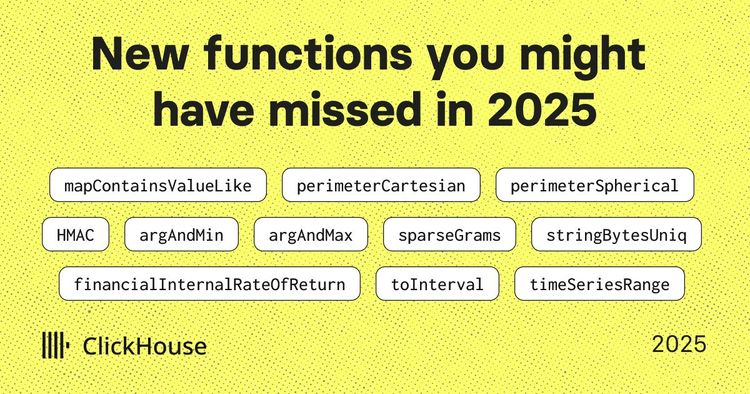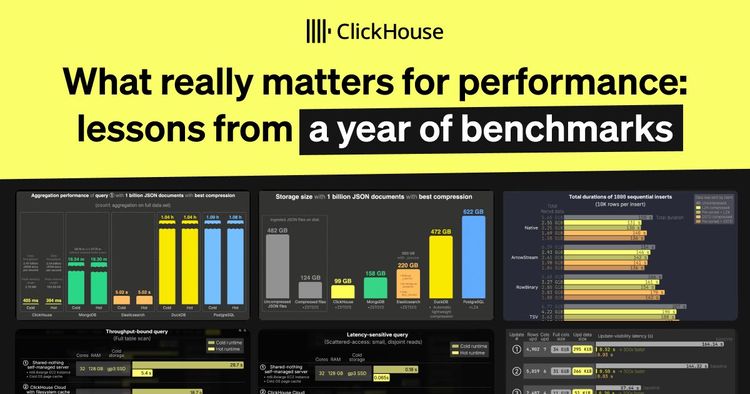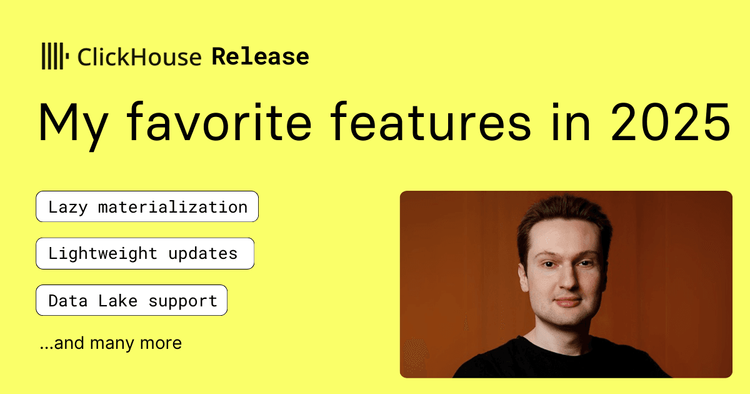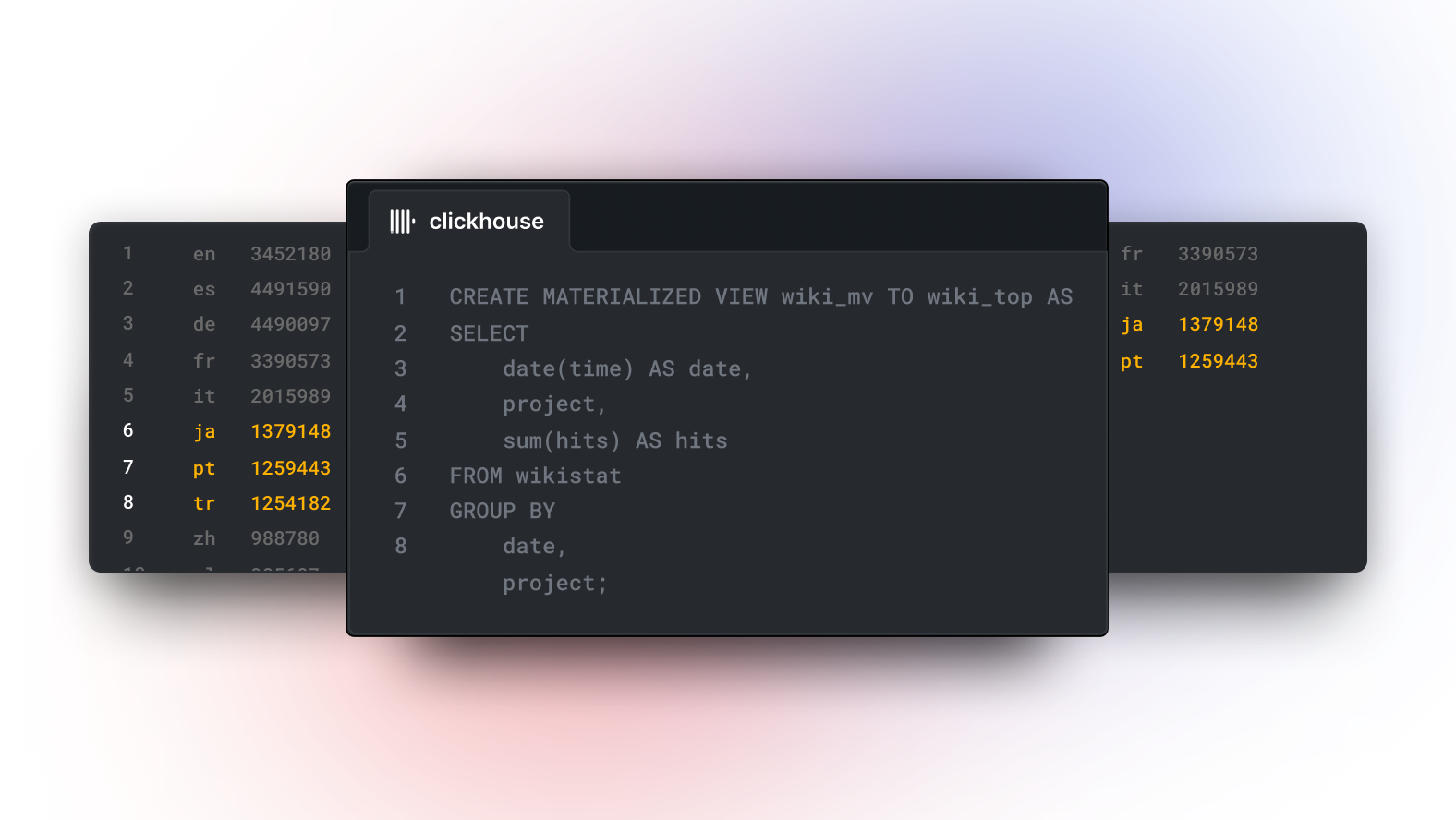
Introduction #
In the real world, data doesn’t only have to be stored, but processed as well. Processing is usually done on an application side using one of the available libraries for ClickHouse. Still, there are some critical processing points that can be moved to ClickHouse to increase the performance and manageability of the data. One of the most powerful tools for that in ClickHouse is Materialized Views. In this blog post, we explore materialized views and how they can be used in ClickHouse for accelerating queries as well as data transformation, filtering and routing tasks.
If you want to learn more about Materialized Views, we offer a free, on-demand training course here.
What is a Materialized View? #
A materialized view is a special trigger that stores the result of a SELECT query on data, as it is inserted, into a target table:
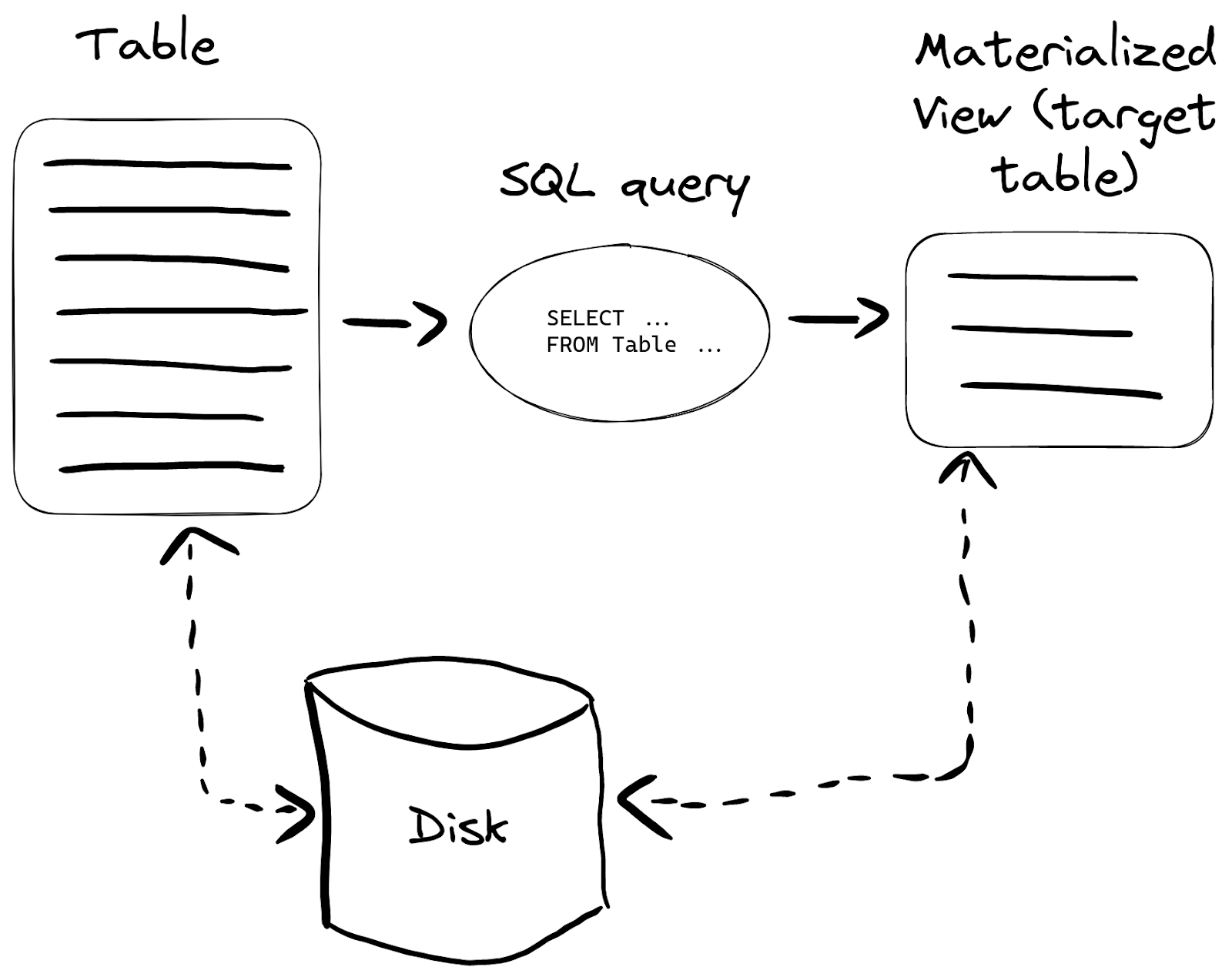
This can be useful in many cases, but let’s take the most popular - making certain queries work faster.
Quick example #
Let’s take 1b rows from the Wikistat dataset as an example:
CREATE TABLE wikistat ( `time` DateTime CODEC(Delta(4), ZSTD(1)), `project` LowCardinality(String), `subproject` LowCardinality(String), `path` String, `hits` UInt64 ) ENGINE = MergeTree ORDER BY (path, time); Ok. INSERT INTO wikistat SELECT * FROM s3('https://ClickHouse-public-datasets.s3.amazonaws.com/wikistat/partitioned/wikistat*.native.zst') LIMIT 1e9
Suppose we frequently query for the most popular projects for a certain date:
SELECT project, sum(hits) AS h FROM wikistat WHERE date(time) = '2015-05-01' GROUP BY project ORDER BY h DESC LIMIT 10
This query takes a ClickHouse Cloud development service 15 seconds to complete:
┌─project─┬────────h─┐ │ en │ 34521803 │ │ es │ 4491590 │ │ de │ 4490097 │ │ fr │ 3390573 │ │ it │ 2015989 │ │ ja │ 1379148 │ │ pt │ 1259443 │ │ tr │ 1254182 │ │ zh │ 988780 │ │ pl │ 985607 │ └─────────┴──────────┘ 10 rows in set. Elapsed: 14.869 sec. Processed 972.80 million rows, 10.53 GB (65.43 million rows/s., 708.05 MB/s.)
If we have plenty of those queries and we need subsecond performance from ClickHouse, we can create a materialized view for this query:
CREATE TABLE wikistat_top_projects ( `date` Date, `project` LowCardinality(String), `hits` UInt32 ) ENGINE = SummingMergeTree ORDER BY (date, project); Ok. CREATE MATERIALIZED VIEW wikistat_top_projects_mv TO wikistat_top_projects AS SELECT date(time) AS date, project, sum(hits) AS hits FROM wikistat GROUP BY date, project;
In these two queries:
wikistat_top_projectsis the name of the table that we’re going to use to save a materialized view,wikistat_top_projects_mvis the name of the materialized view itself (the trigger),- we’ve used SummingMergeTree because we would like to have our hits value summarized for each date/project pair,
- everything that comes after
ASis the query that the materialized view will be built from.
We can create any number of materialized views, but each new materialized view is an additional storage load, so keep the overall number sensible i.e. aim for under 10 per table.
Now let’s populate the materialized view’s target table with the data from wikistat table using the same query:
INSERT INTO wikistat_top_projects SELECT date(time) AS date, project, sum(hits) AS hits FROM wikistat GROUP BY date, project
Query materialized view table #
Since wikistat_top_projects is a table, we have all of the power of ClickHouse SQL to query it:
SELECT project, sum(hits) hits FROM wikistat_top_projects WHERE date = '2015-05-01' GROUP BY project ORDER BY hits DESC LIMIT 10 ┌─project─┬─────hits─┐ │ en │ 34521803 │ │ es │ 4491590 │ │ de │ 4490097 │ │ fr │ 3390573 │ │ it │ 2015989 │ │ ja │ 1379148 │ │ pt │ 1259443 │ │ tr │ 1254182 │ │ zh │ 988780 │ │ pl │ 985607 │ └─────────┴──────────┘ 10 rows in set. Elapsed: 0.003 sec. Processed 8.19 thousand rows, 101.81 KB (2.83 million rows/s., 35.20 MB/s.)
Notice this took ClickHouse 3ms to generate the same result, as opposed to 15 seconds with the original query. Also note, that we still need to use GROUP BY here as the SummingMergeTree engine is asynchronous (this saves resources and reduces impact on query processing) and some values can be uncalculated.
Managing materialized views #
Materialized views can be listed using a SHOW TABLES query:
SHOW TABLES LIKE 'wikistat_top_projects_mv' ┌─name─────────────────────┐ │ wikistat_top_projects_mv │ └──────────────────────────┘
We can drop materialized views using DROP TABLE but this will only delete the trigger itself:
DROP TABLE wikistat_top_projects_mv
Remember to drop the target table as well if it’s not needed anymore:
DROP TABLE wikistat_top_projects
Getting materialized view size on disk #
All metadata on materialized view tables is available in the system database like any other table. E.g., to get its size on disk, we can do the following:
SELECT rows, formatReadableSize(total_bytes) AS total_bytes_on_disk FROM system.tables WHERE table = 'wikistat_top_projects' ┌──rows─┬─total_bytes_on_disk─┐ │ 15336 │ 37.42 KiB │ └───────┴─────────────────────┘
Updating data in materialized views #
The most powerful feature of materialized views is that the data is updated automatically in the target table, when it is inserted into the source tables using the SELECT statement:
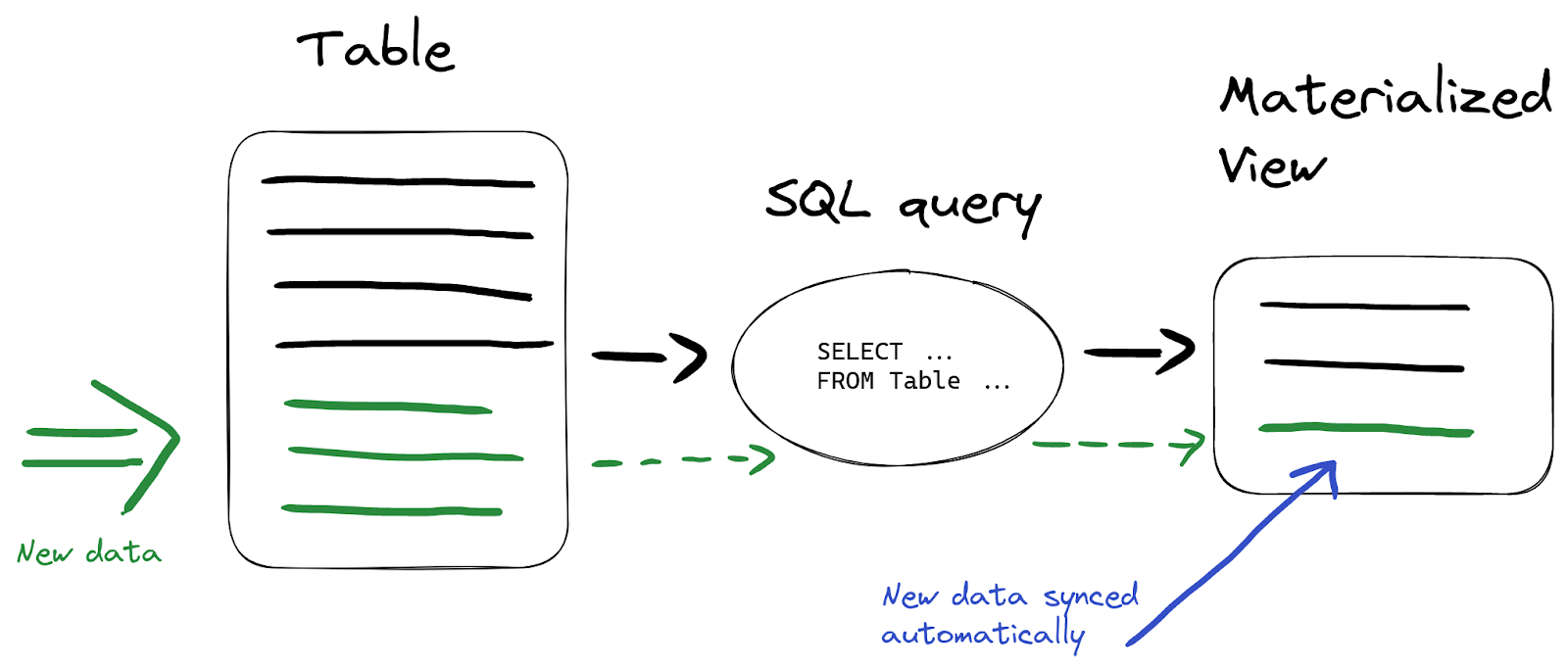
So we don’t have to additionally refresh data in the materialized view - everything is done automatically by ClickHouse. Suppose we insert new data into the wikistat table:
INSERT INTO wikistat VALUES(now(), 'test', '', '', 10), (now(), 'test', '', '', 10), (now(), 'test', '', '', 20), (now(), 'test', '', '', 30);
Now let’s query the materialized view’s target table to verify the hits column is summed properly. We use FINAL modifier to make sure the summing engine returns summarized hits instead of individual, unmerged rows:
SELECT hits FROM wikistat_top_projects FINAL WHERE (project = 'test') AND (date = date(now())) ┌─hits─┐ │ 70 │ └──────┘ 1 row in set. Elapsed: 0.005 sec. Processed 7.15 thousand rows, 89.37 KB (1.37 million rows/s., 17.13 MB/s.)
In production environments avoid FINAL for big tables and always prefer sum(hits) instead. Also check optimize_on_insert settings option which controls how data is merged in insert.
Speed up aggregations using materialized views #
As shown in the previous section, materialized views are a way to improve query performance. All kinds of aggregations are common for analytical queries, not only sum() as shown in the previous example. The SummingMergeTree is useful for keeping a total of values, but there are more advanced aggregations that can be computed using the AggregatingMergeTree engine.
Suppose we have the following type of query being executed frequently:
SELECT toDate(time) AS date, min(hits) AS min_hits_per_hour, max(hits) AS max_hits_per_hour, avg(hits) AS avg_hits_per_hour FROM wikistat WHERE project = 'en' GROUP BY date
This gives us the monthly min, max and average of hits per day for the given project:
┌───────date─┬─min_hits_per_hour─┬─max_hits_per_hour─┬──avg_hits_per_hour─┐ │ 2015-05-01 │ 1 │ 36802 │ 4.586310181621408 │ │ 2015-05-02 │ 1 │ 23331 │ 4.241388590780171 │ │ 2015-05-03 │ 1 │ 24678 │ 4.317835245126423 │ ... └────────────┴───────────────────┴───────────────────┴────────────────────┘ 38 rows in set. Elapsed: 8.970 sec. Processed 994.11 million rows
Note here that our raw data is already aggregated by the hour.
Let's store these aggregated results using a materialized view for faster retrieval. Aggregated results are defined using state combinators. State combinators ask ClickHouse to save the internal aggregated state instead of the final aggregation result. This allows using aggregations without having to save all records with original values. The approach is quite simple - we use *State() functions when creating materialized views and then their corresponding *Merge() functions at query time to get the correct aggregate results:

We’ll use min, max, and avg states in our example. In the target table for a new materialized view we’re going to use AggregateFunction type to store aggregation states instead of values:
CREATE TABLE wikistat_daily_summary ( `project` String, `date` Date, `min_hits_per_hour` AggregateFunction(min, UInt64), `max_hits_per_hour` AggregateFunction(max, UInt64), `avg_hits_per_hour` AggregateFunction(avg, UInt64) ) ENGINE = AggregatingMergeTree ORDER BY (project, date); Ok. CREATE MATERIALIZED VIEW wikistat_daily_summary_mv TO wikistat_daily_summary AS SELECT project, toDate(time) AS date, minState(hits) AS min_hits_per_hour, maxState(hits) AS max_hits_per_hour, avgState(hits) AS avg_hits_per_hour FROM wikistat GROUP BY project, date
Let’s also populate it with data:
INSERT INTO wikistat_daily_summary SELECT project, toDate(time) AS date, minState(hits) AS min_hits_per_hour, maxState(hits) AS max_hits_per_hour, avgState(hits) AS avg_hits_per_hour FROM wikistat GROUP BY project, date 0 rows in set. Elapsed: 33.685 sec. Processed 994.11 million rows
At the query time, we use the corresponding Merge combinator to retrieve values:
SELECT date, minMerge(min_hits_per_hour) min_hits_per_hour, maxMerge(max_hits_per_hour) max_hits_per_hour, avgMerge(avg_hits_per_hour) avg_hits_per_hour FROM wikistat_daily_summary WHERE project = 'en' GROUP BY date
Notice we get exactly the same results but thousands of times faster:
┌───────date─┬─min_hits_per_hour─┬─max_hits_per_hour─┬──avg_hits_per_hour─┐ │ 2015-05-01 │ 1 │ 36802 │ 4.586310181621408 │ │ 2015-05-02 │ 1 │ 23331 │ 4.241388590780171 │ │ 2015-05-03 │ 1 │ 24678 │ 4.317835245126423 │ ... └────────────┴───────────────────┴───────────────────┴────────────────────┘ 32 rows in set. Elapsed: 0.005 sec. Processed 9.54 thousand rows, 1.14 MB (1.76 million rows/s., 209.01 MB/s.)
Any aggregate function can be used with State/Merge combinator as a part of an aggregating materialized view.
Compacting data to optimize storage #
In some cases we only need to store aggregated data but ingesting is done in an event-based manner. If we still need raw data for the latest couple of days and it’s fine to save aggregated history, we can combine a materialized view and TTL for the source table.
To optimize storage space, we can also declare column types explicitly to make sure the schema is optimal. Suppose we want to store monthly aggregated data only for each path from wikistat table:
CREATE MATERIALIZED VIEW wikistat_monthly_mv TO wikistat_monthly AS SELECT toDate(toStartOfMonth(time)) AS month, path, sum(hits) AS hits FROM wikistat GROUP BY path, month
The original table (data stored hourly) takes 3x more disk space than the aggregated materialized view:
| wikistat (original table) | wikistat_daily (materialized view) |
|---|---|
| 1.78GiB | 565.68 MiB |
| 1b rows | ~ 27m rows |
An important note here is that compacting only makes sense when the resulting number of rows will reduce by at least 10 times. In other cases, ClickHouse's powerful compression and encoding algorithms will show comparable storage efficiency without any aggregations.
Now that we have monthly aggregations, we can add a TTL expression to the original table so that the data is deleted after 1 week:
ALTER TABLE wikistat MODIFY TTL time + INTERVAL 1 WEEK
Validating and filtering data #
Another popular example when materialized views are used is processing data right after insertion. Data validation is a good example.
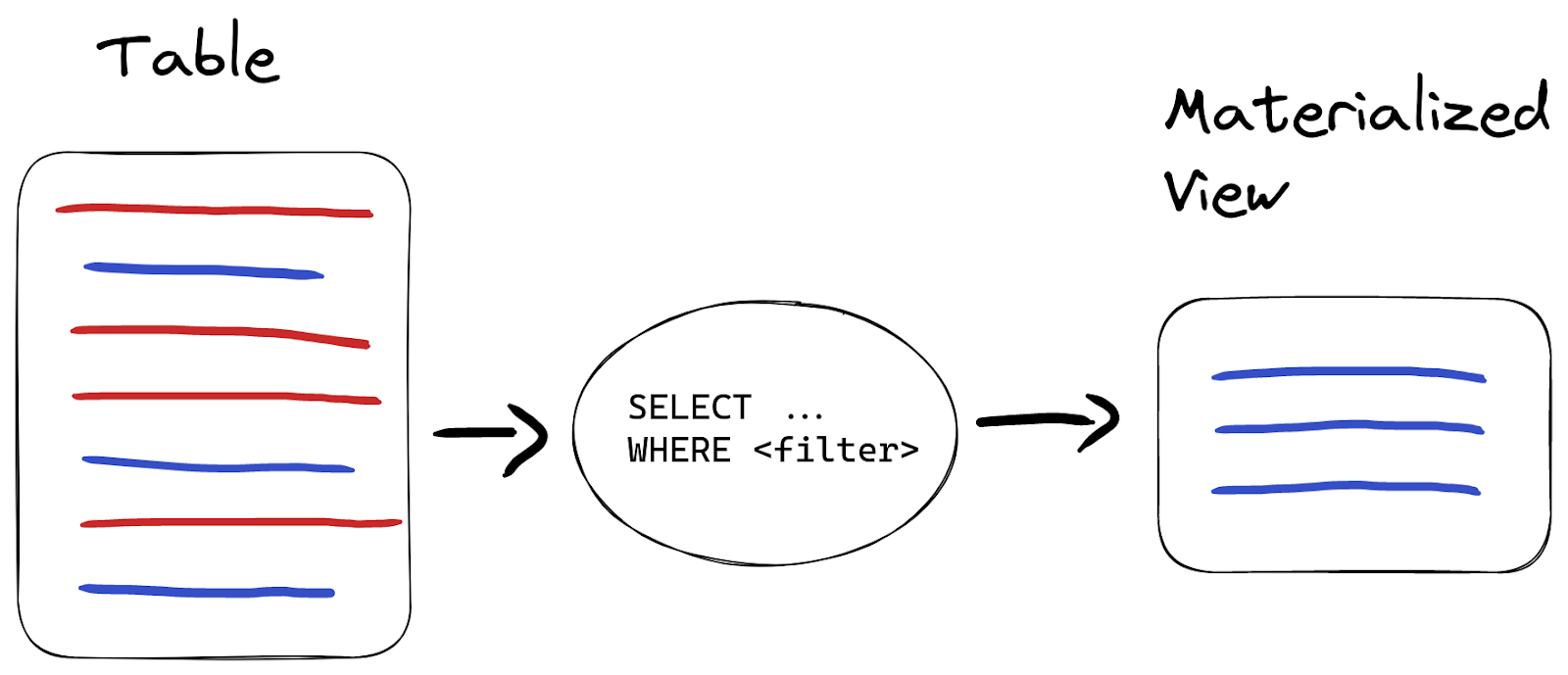
Let’s say we want to filter out all path values that contain unwanted symbols before saving them into the resulting table with clean data. We have around 1% of such values in our table:
SELECT count(*) FROM wikistat WHERE NOT match(path, '[a-z0-9\\-]') LIMIT 5 ┌──count()─┐ │ 12168918 │ └──────────┘ 1 row in set. Elapsed: 46.324 sec. Processed 994.11 million rows, 28.01 GB (21.46 million rows/s., 604.62 MB/s.)
To implement validation filtering we’ll need 2 tables - a table with all data and a table with clean data only. The materialized view’s target table will play the role of a final table with clean data, and the source table will be transitory. We can remove data from the source table either based on TTL, as we did in the previous section, or change the engine of this table to Null, which does not store any data (the data will only be stored in the materialized view):
CREATE TABLE wikistat_src ( `time` DateTime, `project` LowCardinality(String), `subproject` LowCardinality(String), `path` String, `hits` UInt64 ) ENGINE = Null
Now let’s create a materialized view using a data validation query:
CREATE TABLE wikistat_clean AS wikistat; Ok. CREATE MATERIALIZED VIEW wikistat_clean_mv TO wikistat_clean AS SELECT * FROM wikistat_src WHERE match(path, '[a-z0-9\\-]')
When we insert data, wikistat_src will remain empty:
INSERT INTO wikistat_src SELECT * FROM s3('https://ClickHouse-public-datasets.s3.amazonaws.com/wikistat/partitioned/wikistat*.native.zst') LIMIT 1000
Let’s make sure source table is empty:
SELECT count(*) FROM wikistat_src ┌─count()─┐ │ 0 │ └─────────┘
But our wikistat_clean materialized table now has only valid rows:
SELECT count(*) FROM wikistat_clean ┌─count()─┐ │ 58 │ └─────────┘
The other 942 rows (1000 - 58) were excluded by our validation statement at insert time.
Routing data to tables #
Another example materialized views can be used for is to route data to different tables based on certain conditions:
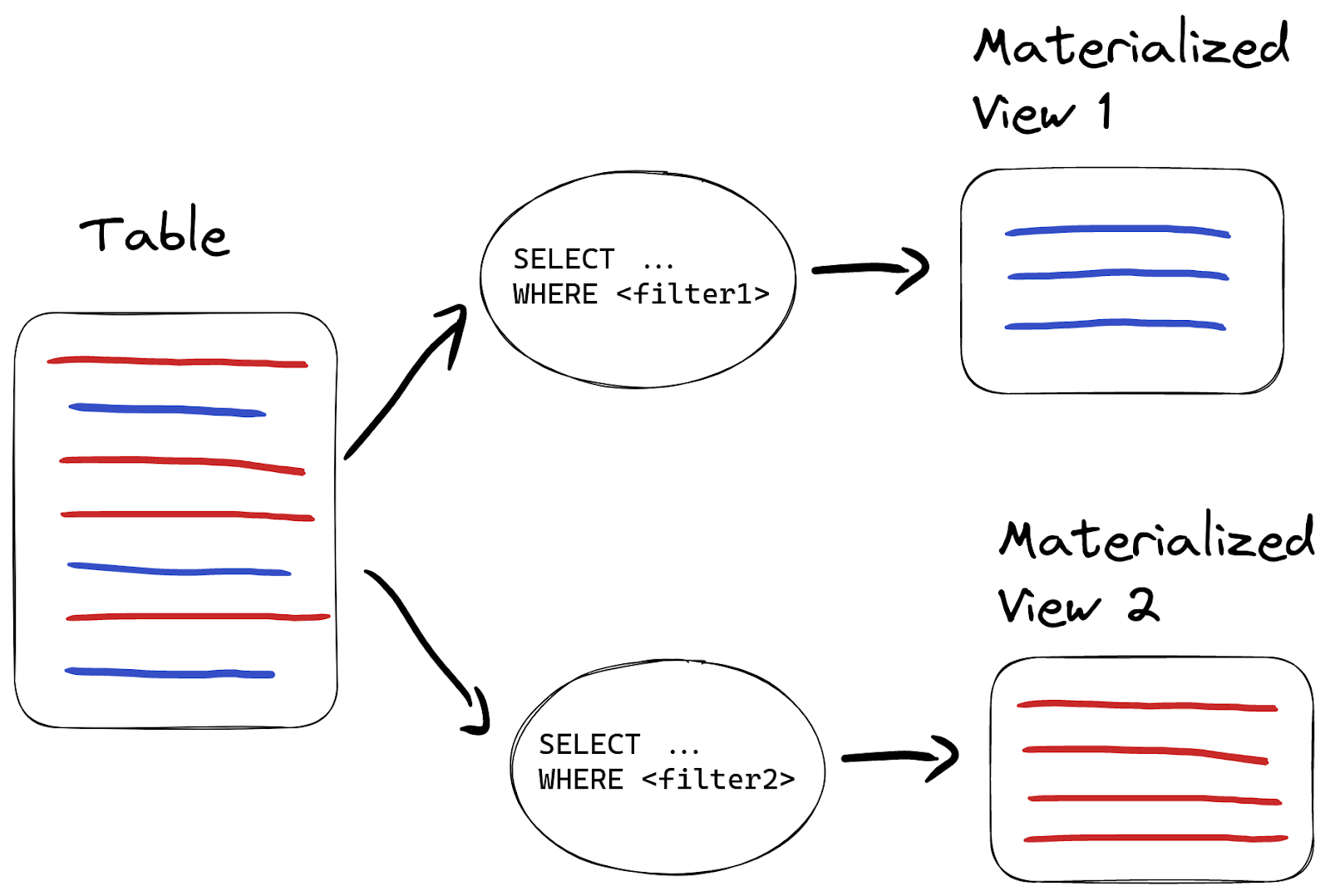
For example, we might want to route invalid data into another table instead of dropping it. In that case, we create another materialized view but with a different query:
CREATE TABLE wikistat_invalid AS wikistat; Ok. CREATE MATERIALIZED VIEW wikistat_invalid_mv TO wikistat_invalid AS SELECT * FROM wikistat_src WHERE NOT match(path, '[a-z0-9\\-]')
When we have single materialized views for the same source table, they will be processed in the alphabetical order. Remember not to create more than the order of tens of materialized views per source table as insert performance can degrade.
If we insert the same data again, we will find 942 invalid rows in wikistat_invalid materialized view:
SELECT count(*) FROM wikistat_invalid ┌─count()─┐ │ 942 │ └─────────┘
Transforming data #
Since materialized views are based on the result of a query, we can use all the power of ClickHouse functions in our SQL to transform source values to enrich and improve data clarity. As a quick example, let’s merge project, subproject and path columns into a single page column and split time into date and hour columns:
CREATE TABLE wikistat_human ( `date` Date, `hour` UInt8, `page` String ) ENGINE = MergeTree ORDER BY (page, date); Ok. CREATE MATERIALIZED VIEW wikistat_human_mv TO wikistat_human AS SELECT date(time) AS date, toHour(time) AS hour, concat(project, if(subproject != '', '/', ''), subproject, '/', path) AS page, hits FROM wikistat
Now wikistat_human will be populated with the transformed data on the fly:
┌───────date─┬─hour─┬─page──────────────────────────┬─hits─┐ │ 2015-11-08 │ 8 │ en/m/Angel_Muñoz_(politician) │ 1 │ │ 2015-11-09 │ 3 │ en/m/Angel_Muñoz_(politician) │ 1 │ └────────────┴──────┴───────────────────────────────┴──────┘
Creating materialized views in production #
New data is automatically added to a materialized view’s target table when source data arrives. But in order to populate materialized view with existing data on production environments we have to follow some simple steps:
- Pause write to the source table.
- Create materialized view.
- Populate the target table with data from the source table.
- Restart writes to the source table.
Alternatively, we can use a certain time point in the future while creating materialized view:
CREATE MATERIALIZED VIEW mv TO target_table AS SELECT … FROM soruce_table WHERE date > `$todays_date`
Where $todays_date should be replaced with an absolute date. Thus our materialized view will begin triggering tomorrow, so we have to wait until tomorrow and populate historical data with the following query:
INSERT INTO target_table SELECT ... FROM soruce_table WHERE date <= `$todays_date`
Materialized views and JOINs #
Since materialized views work with a result of an SQL query, we can use JOINs as well as any other SQL feature. But JOINs should be used with caution.
Suppose we have a table with page titles for our wikistat dataset:
CREATE TABLE wikistat_titles ( `path` String, `title` String ) ENGINE = MergeTree ORDER BY path
This table has page titles associated with path:
SELECT * FROM wikistat_titles ┌─path─────────┬─title────────────────┐ │ Ana_Sayfa │ Ana Sayfa - artist │ │ Bruce_Jenner │ William Bruce Jenner │ └──────────────┴──────────────────────┘
We can now create a materialized view that joins title from the wikistat_titles table on the path value:
CREATE TABLE wikistat_with_titles ( `time` DateTime, `path` String, `title` String, `hits` UInt64 ) ENGINE = MergeTree ORDER BY (path, time); Ok. CREATE MATERIALIZED VIEW wikistat_with_titles_mv TO wikistat_with_titles AS SELECT time, path, title, hits FROM wikistat AS w INNER JOIN wikistat_titles AS wt ON w.path = wt.path
Note that we use INNER JOIN, so we’ll have only records that have corresponding values in the wikistat_titles table after populating:
SELECT * FROM wikistat_with_titles LIMIT 5 ┌────────────────time─┬─path──────┬─title──────────────┬─hits─┐ │ 2015-05-01 01:00:00 │ Ana_Sayfa │ Ana Sayfa - artist │ 5 │ │ 2015-05-01 01:00:00 │ Ana_Sayfa │ Ana Sayfa - artist │ 7 │ │ 2015-05-01 01:00:00 │ Ana_Sayfa │ Ana Sayfa - artist │ 1 │ │ 2015-05-01 01:00:00 │ Ana_Sayfa │ Ana Sayfa - artist │ 3 │ │ 2015-05-01 01:00:00 │ Ana_Sayfa │ Ana Sayfa - artist │ 653 │ └─────────────────────┴───────────┴────────────────────┴──────┘
Let’s insert a new record into the wikistat table to see how our new materialized view works:
INSERT INTO wikistat VALUES(now(), 'en', '', 'Ana_Sayfa', 123); 1 row in set. Elapsed: 1.538 sec.
Note the high insert time here - 1.538 sec. We can see our new row in wikistat_with_titles:
SELECT * FROM wikistat_with_titles ORDER BY time DESC LIMIT 3 ┌────────────────time─┬─path─────────┬─title────────────────┬─hits─┐ │ 2023-01-03 08:43:14 │ Ana_Sayfa │ Ana Sayfa - artist │ 123 │ │ 2015-06-30 23:00:00 │ Bruce_Jenner │ William Bruce Jenner │ 115 │ │ 2015-06-30 23:00:00 │ Bruce_Jenner │ William Bruce Jenner │ 55 │ └─────────────────────┴──────────────┴──────────────────────┴──────┘
But what happens if we add data to the wikistat_titles table? Let’s check:
INSERT INTO wikistat_titles VALUES('Academy_Awards', 'Oscar academy awards');
Nothing will appear in the materialized view even though we have corresponding values in the wikistat table:
SELECT * FROM wikistat_with_titles WHERE path = 'Academy_Awards' 0 rows in set. Elapsed: 0.003 sec.
This is because a materialized view only triggers when its source table receives inserts. It's just a trigger on the source table and knows nothing about the join table. Note that this doesn't only apply to join queries, and is relevant when introducing any table external in the materialized view's SELECT statement e.g. using a IN SELECT.
In our case, wikistat is the source table for the materialized view, and wikistat_titles is a table we join to:
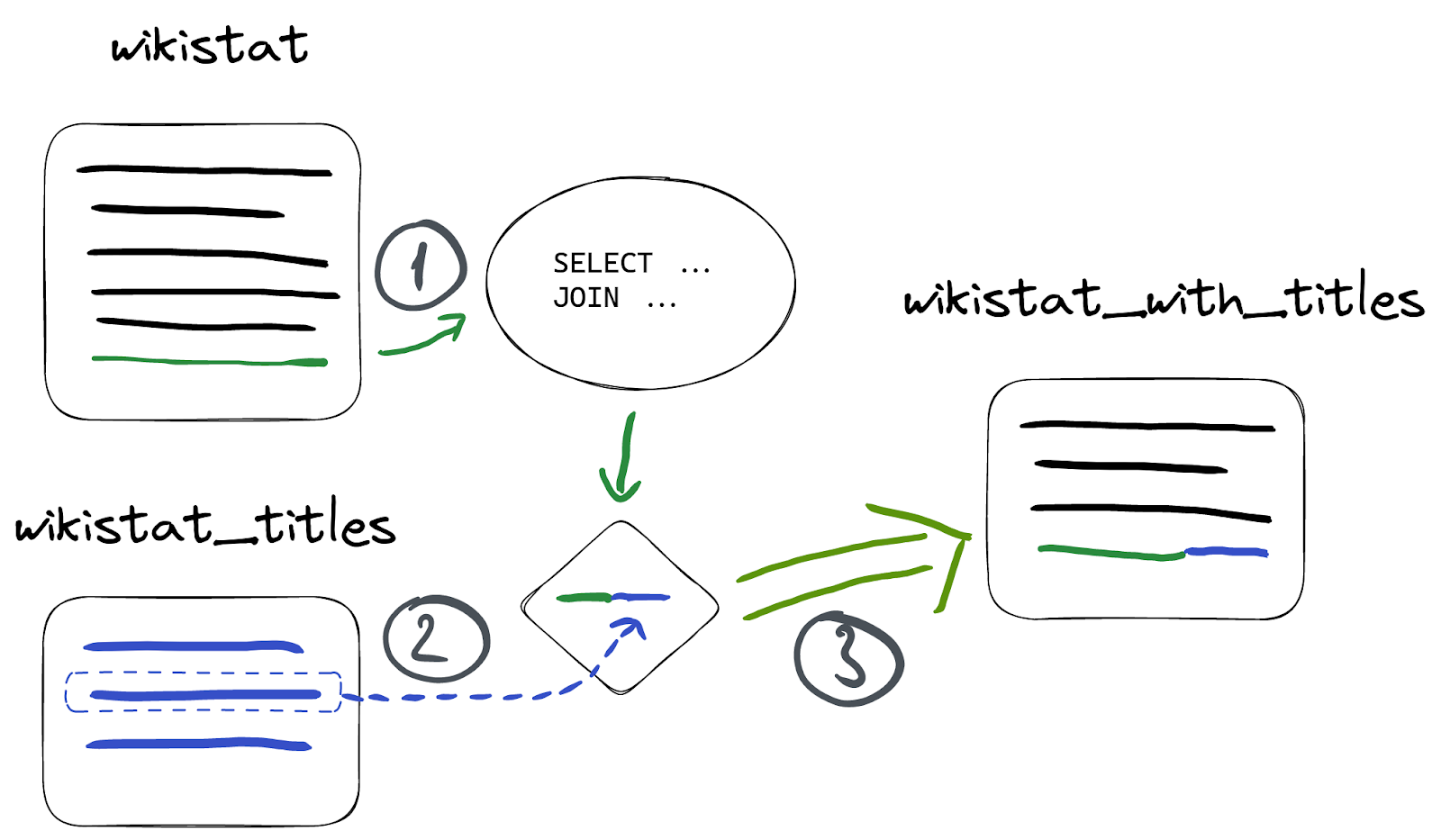
This is why nothing appeared in our materialized view - nothing was inserted into wikistat table. But let’s insert something to it:
INSERT INTO wikistat VALUES(now(), 'en', '', 'Academy_Awards', 456);
We can see new records in materialized view:
SELECT * FROM wikistat_with_titles WHERE path = 'Academy_Awards' ┌────────────────time─┬─path───────────┬─title────────────────┬─hits─┐ │ 2023-01-03 08:56:50 │ Academy_Awards │ Oscar academy awards │ 456 │ └─────────────────────┴────────────────┴──────────────────────┴──────┘
Be careful, since JOINs can dramatically downgrade insert performance when joining on large tables as shown above. Consider using dictionaries as a more efficient alternative.
Summary #
In this blog post, we’ve explored how materialized views are a powerful tool in ClickHouse to improve query performance and extend data management capabilities. You can even use JOINs with materialized views. Consider materialized columns as a quick alternative when no aggregation or filtering is required.
